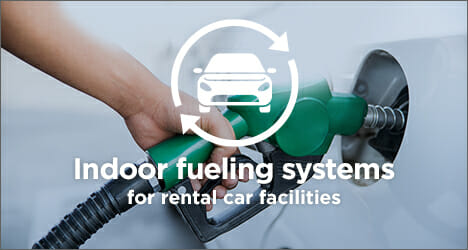Working with EPCs — End-to-End Renewable Energy Engineering Learn More
Engineering indoor fueling systems for rental car facilities

Blymyer Engineers designs commercial indoor fueling systems for vehicle fleet operators in the Bay Area, the United States, and in international markets. Much of the recent demand for indoor fueling systems has been driven by the rental car industry, and the move to consolidated rental car facilities at major airports.
“Our team actually designed the first multi-story fueling system for a consolidated rental car facility in the United States,” says Blymyer President Mike Rantz. “These facilities—which you have undoubtedly encountered if you travel regularly in the United States—are more efficient for consumers and rental fleet operators.”
Taking the whole process into account
Like virtually all fleet fueling facilities, rental car projects require efficient access for vehicles. But they also routinely require safe indoor fueling across a multi-level building that needs to efficiently serve maintenance crews and consumers. When these facilities call for indoor fueling, added layers of fire code and construction complexity come into play.
“Indoor fueling is often a feature of new consolidated rental car facilities, but you also encounter indoor systems in traditional rental car facilities and remodels of existing facilities,” says Bjorn Enstrom, a project manager who regularly leads fuel system design projects at Blymyer. “Our design process takes local fire code requirements into account. During construction, we provide construction administration, assisting contractors by answering questions and resolving problems.”
Indoor fueling supports better travel experiences
Enstrom anticipates growing demand for indoor fueling at rental car facilities, especially at airports. He says: “Indoor fueling systems are a key contributor to enabling fast vehicle turnaround for operators. Cost and convenience benefits flow to rental car consumers as a result. As more airports turn to consolidated rental car facilities, we expect to see more projects calling for indoor fueling systems.”